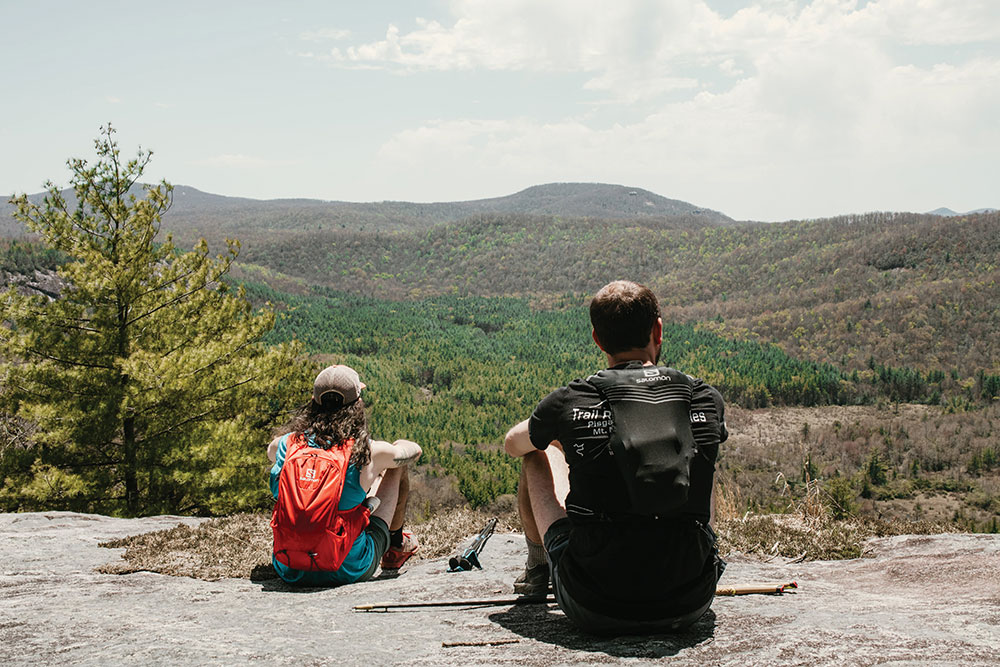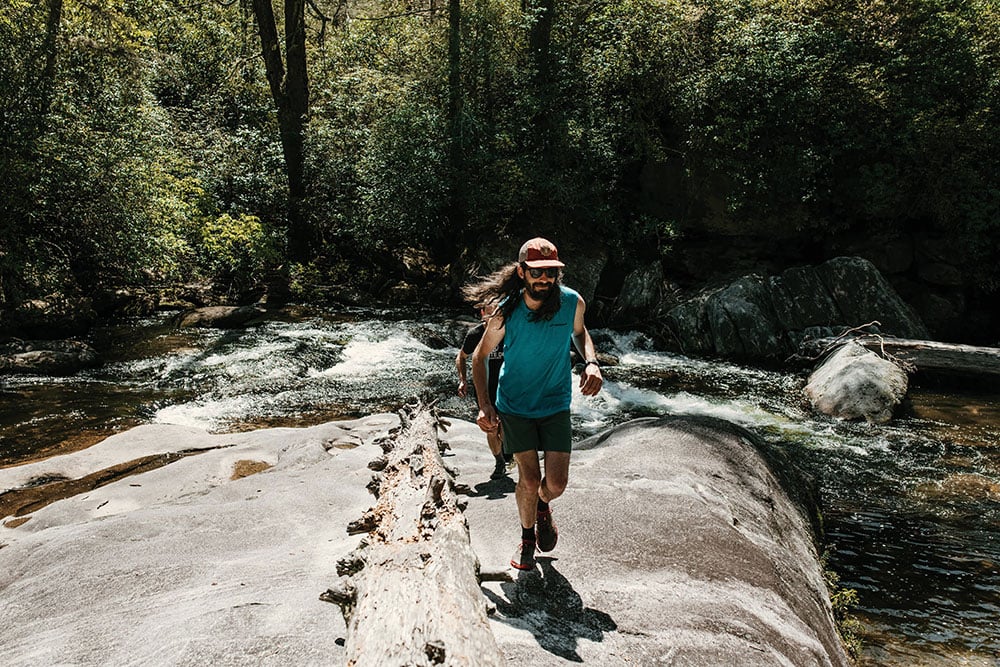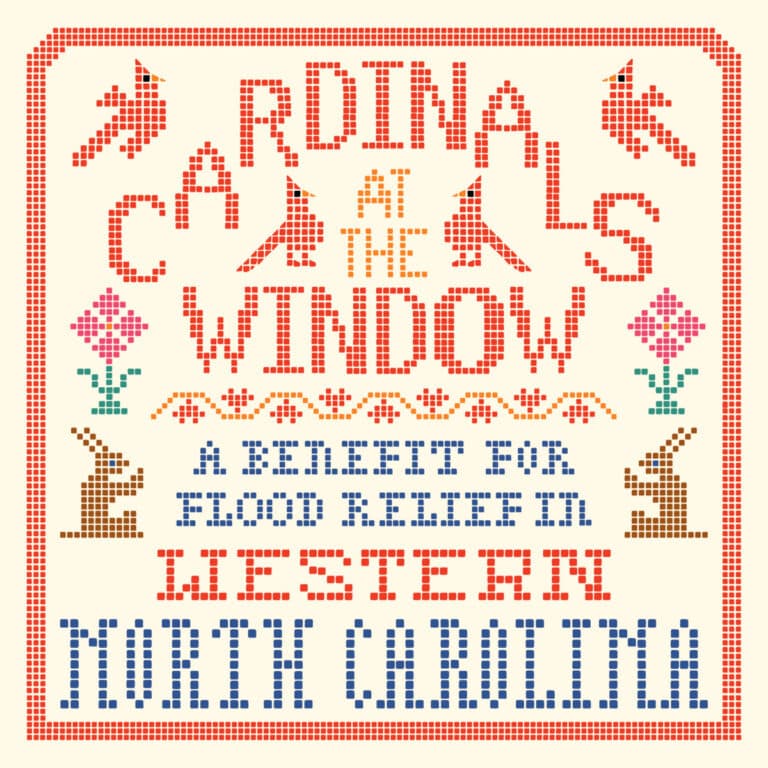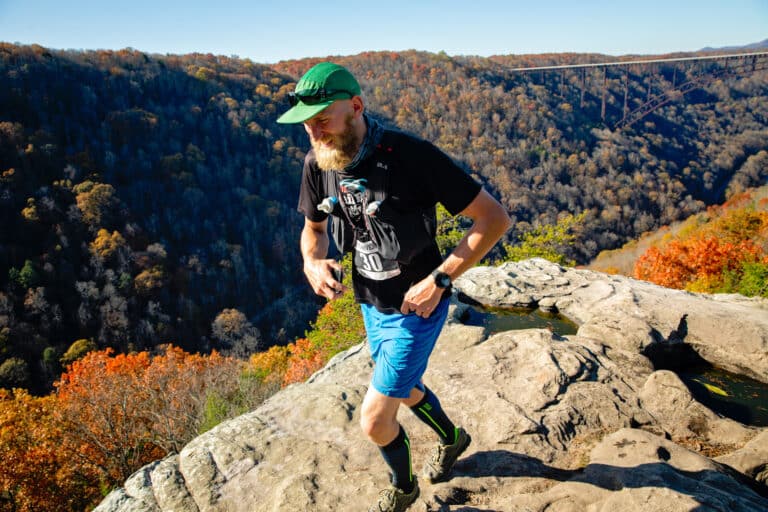This guide will take you deep in the mountains of western North Carolina.
Looking out from John Rock you have a vantage point across the Ranger District of the Pisgah National Forest. Directly to the north is the unmistakable monolith of Looking Glass Rock. Beyond it, glimpses of the Blue Ridge Parkway. Off to the west, Pilot Mountain, Sam Knob, Black Balsam Knob—a serrated horizon of peaks reaching upward toward 6,000 feet. Between all of it, a spider web of trails within the ranger district’s more than 160,000 acres—twisting through rhododendron, past waterfalls, and linking vistas. It makes for a trail runner’s haven. Brendon Voelker, the owner of White Dot Adventures, a guided trail running company based in western North Carolina, would be happy to show you around.
“There are a few thousand miles of trail within an hour or two drive of Asheville, and nobody to take you out on a run,” says Voelker, who started his guide company in the spring of 2019.
Voelker settled in the Asheville area full time in late 2018. He had spent the previous few years on the road, working as an East Coast bike rep, and wintering in the Southeast adventure hub. When he decided to plant roots in North Carolina, he already knew he wanted to put his gained knowledge of the trail networks to use. The initial goal, though, was to join the race scene, organizing a calendar of mass-start events.
“I had a couple of 100-mile courses figured out, but I started asking myself, ‘Why would I want to charge people to do a race with a couple hundred people? What if I just took them out on trips as a personal guide?’ I noticed when people come to Asheville they are always recommended to go check out the same trails. There is plenty of wilderness out there. As long as you have someone who knows where they are.”
White Dot Adventures, which Voelker named for the markings of the Mountains-to-Sea Trail, has permits to operate in the Pisgah and Nantahala National Forests, more than one million acres of public land. And Voelker is up to provide trail runners with anything they are looking for, whether it be a five-mile morning, or tackling a bucket list run like the 30-mile, point-to-point route of the Art Loeb Trail. He is also available to provide support for other’s endeavors, or take a couple for a leisurely hike. That John Rock view is no secret, but it is a moderately challenging go-to for Voelker to familiarize runners with the area—5.5 miles, 1,000 feet of climbing, a scenic waterfall, and a view of plenty more possibilities. Voelker’s priorities are tailoring the experience to the client and articulating that a running tour is anything but a race.
“If you want to take a side trip to an overlook, or stop to check out a waterfall, we can. If you want to pack a beer in your drop bag, you can stop and have a beer. This is your day on the trail,” says Voelker. “I start every outing by saying, ‘If we walk the entire day, we walk.’ There is that aspect to trail running—hiking, power hiking, stopping for breaks, soaking in views.”

According to an Outdoor Industry Association report to be published later this year, there are approximately 11.9 million trail runners in the U.S. That is double what it was a decade ago. Over the past three years, participation has grown at an average of nine percent. You might expect there to be more trail running guides. Yet Voelker is part of an exceptional few in the U.S. There are coaches, and some companies offering mark-your-calendar, multi-day “runcations.” But the idea of looking up a local trail running service and booking a day trip, the way you would for whitewater rafting or even mountain biking, just isn’t much of a thing. Google brings up a few similar outfits in New Hampshire, Colorado, and Lake Tahoe, but they too stand in lonely company.
City running tours have been a growing offering over the past decade, begging the question: Will trail running gain more outfitters like White Dot in the coming years? A website based in the Netherlands, Runningtours.net, curates a global menu of independent tours. It has 170 running operators listed worldwide, with 26 in the U.S., 25 of which are city running tours. The other is White Dot Adventures.
Another local guide service, Asheville Adventures, does lead trail running in western North Carolina. The company is geared towards hiking, but their tours also include a city run of Asheville, a 5K trail run, and coming soon, a 10K trail run.
Running is often called one of the most accessible sports. The oft-touted verse is that all you need is a pair of shoes. Throw in a dozen or so available navigational applications, and perhaps the question is, why would you pay for a trail running guide?
“Some days you drive by a trailhead like Looking Glass Rock, and it is just packed,” says Kyle Bergemann, a software engineer and Voelker’s running partner. Bergemann has also stepped in to help Voelker take clients out on occasion.
“There is a big benefit to running with someone who knows the trails like the back of their hand, and not just going to the top 10 list on AllTrails. Brendon just has an energy about him out there with people. He loves it.”
Prior to the public health restrictions of 2020, mass races could be argued as the most popular way to trail run in different destinations. As many have changed approaches to other facets of life, perhaps there is a growing place for a different sort of challenge we pay an organizer for. One that moves at a different pace, and has us checking our watch less often. Maybe the next time we plan to visit a national forest, the question should be, why wouldn’t we want someone to guide us for a run through the mountains?
“These thoughts are running through my head,” says Voelker. “All these stories about these trails and unique places I have been learning [about]. I love being able to share those with somebody.”
Cover photo: Brendon Voelker, running in North Carolina’s Panthertown Valley in the Nantahala National Forest. Photo By LJ Gay courtesy of White Dot Adventures







